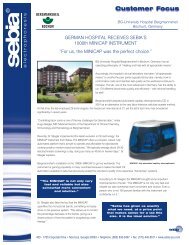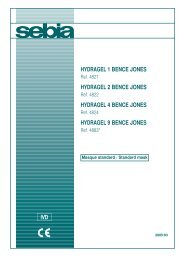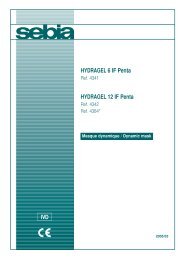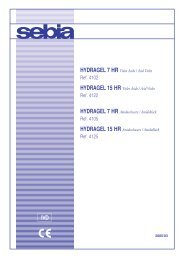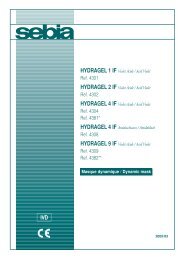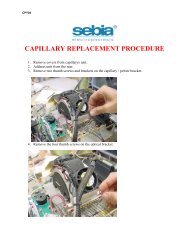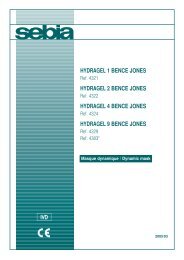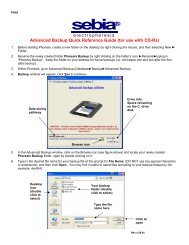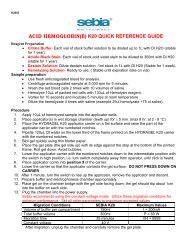CAPILLARYS HEMOGLOBIN(E)
CAPILLARYS HEMOGLOBIN(E) - Sebia Electrophoresis
CAPILLARYS HEMOGLOBIN(E) - Sebia Electrophoresis
- No tags were found...
Create successful ePaper yourself
Turn your PDF publications into a flip-book with our unique Google optimized e-Paper software.
<strong>CAPILLARYS</strong> <strong>HEMOGLOBIN</strong>(E) - 2010/10<br />
Hemoglobin C<br />
One glutamic acid of the ß-chain is substituted by a lysine (a basic amino acid No. 6): its mobility is strongly reduced. When compared to Hb A, its<br />
isoelectric point is highly elevated and its total negative charge decreased with the analysis pH. Its electrophoretic mobility is therefore increased in<br />
the capillary and this hemoglobin is faster than A, F and S fractions.<br />
Hemoglobins C, E and O-Arab are not superimposed on the electrophoretic pattern and can easily be identified.<br />
Hemoglobin E<br />
One glutamic acid of the ß-chain (No. 26) is substituted by a lysine. With the <strong>CAPILLARYS</strong> CORD BLOOD procedure, hemoglobin E migrates<br />
anodically behind hemoglobin C and is totally separated from it. Then, it is possible to diagnose a heterozygous C / E patient.<br />
Hemoglobin O-Arab<br />
One glutamic acid of the ß-chain (No. 121) is substituted by a lysine. With the <strong>CAPILLARYS</strong> CORD BLOOD procedure, hemoglobin O-Arab migrates<br />
separately between E and C fractions. When the blood sample contains Hb A2, Hb O-Arab migrates exactly like this hemoglobin. The analysis being<br />
performed on new-borns blood samples, with very low Hb A2 concentration, in such a case, Hb A2 does not interfere on Hb O-Arab detection.<br />
Hemoglobin D (-Los Angeles)<br />
One glutamic acid of the ß-chain (No. 121) is substituted by a glutamine. With the <strong>CAPILLARYS</strong> CORD BLOOD procedure, hemoglobin D (called<br />
D-Punjab, D-Los Angeles, D-Chicago or D-Portugal) migrates behind hemoglobin S, this property allows for the differentiation of S and D hemoglobins.<br />
2. Quantitative abnormalities: Thalassemias<br />
Thalassemias constitute a quite heterogeneous group of genetic disorders characterized by decreased synthesis of one type of the polypeptide chains.<br />
The molecular mechanism of this decrease has not been fully described.<br />
There are two types of thalassemia syndromes:<br />
Alpha-thalassemias<br />
They are characterized by the decrease of synthesis of the α-chains, consequently affecting the synthesis of all normal hemoglobins. The excess of<br />
synthesis of the ß- and γ-chains in relation to α-chains induces the formation of tetramers without any α-chain:<br />
• hemoglobin Bart’s = γ4,<br />
• hemoglobin H = ß4.<br />
Hemoglobin Bart’s, which presents a low isoelectric point, is in blood samples from new-borns but also, less frequently, in blood samples from adults.<br />
Hemoglobin H is not detected in blood sample from new-borns. With the <strong>CAPILLARYS</strong> CORD BLOOD procedure, hemoglobin Bart’s migrates more<br />
anodic than hemoglobin F (and may appear as a wide fraction not focused).<br />
Beta-thalassemias<br />
They are characterized by the decrease of synthesis of the ß-chains. Only hemoglobin A synthesis is affected. Since the analysis is made on umbilical<br />
cord blood samples from new-borns, the amount of hemoglobin A2 in the sample does not allow the diagnostic of beta-thalassemias.<br />
The <strong>CAPILLARYS</strong> CORD BLOOD procedure is not intended to the diagnostic of beta-thalassemias in new-borns.<br />
3. Particular cases<br />
• Hemoglobin A2 is generally absent or in low concentration in umbilical cord blood samples from new-borns, according to the term of pregnancy. In<br />
a normal new-born blood sample, hemoglobin F is the major fraction, hemoglobin A is the minor one and hemoglobin A2 is generally absent or in<br />
low concentration. When a larger fraction appears in the Hb A2 migration zone, a variant may be suspected.<br />
In this case, the fraction appeared in the Hb A2 migration zone will be detected by the <strong>CAPILLARYS</strong> system but it is necessary to perform<br />
complementary analyses in order to confirm the variant.<br />
• When there is no hemoglobin A in the sample or present at a low level (blood sample from premature baby, beta chain deficiency, etc), or in aged<br />
samples, a fraction may be observed in the C9 migration zone before the C10 migration zone of Hb A. This fraction is acetylated F hemoglobin and<br />
degraded F hemoglobin. The <strong>CAPILLARYS</strong> system can identify this acetylated hemoglobin separately from the hemoglobin A without any confusion.<br />
• When analysing blood samples from newborn babies, Hb A from samples containing Hb F at high concentrations may be disturbed, especially due<br />
to the presence of degraded Hb F in its migration zone. The Hb A percentage indicated by the software may be overvalued. In addition, when<br />
hemoglobin variants (> 4 %, such as Hb S, Hb C, Hb E or Hb D-Punjab) are present in blood samples containing high Hb F levels (> 60 %), it is<br />
necessary to perform complementary analyses in order to confirm the presence of Hb A.<br />
IMPORTANT: When analyzing blood samples without hemoglobin A but with one or many abnormal X variants, it is possible to consider the level<br />
of abnormal X fractions and that of the hemoglobin fraction located in the degraded Hb F migration zone to analyze the electrophoretic pattern: a<br />
low fraction located in C9 and C10 migration zones can not be considered as Hb A if abnormal fractions are in large proportion. In most cases, A /X<br />
heterozygous samples have Hb A and variants X fractions at the same intensity, sometimes with Hb A fraction higher than variant X.<br />
• Some hemoglobin variants (such as Hb Porto-Alegre and Hb Q-Thailand, for example) migrate close to Hb F and may be partially separated from<br />
it. The <strong>CAPILLARYS</strong> system can identify Hb F without any confusion due to the large proportion of Hb F in new-born blood sample.<br />
• Alpha-thalassemia (deletion of one to three α chains) may be detected on the electrophoretic pattern due to the presence of Hb Bart’s. The deletion<br />
of only one chain induces silent alpha-thalassemia because it is asymptomatic. The deletion of 2 or 3 α chains induces quantities of Hb Bart’s on<br />
the electrophoretic pattern.<br />
• When analysing cord blood samples from transfused new-borns with high Hb A level, the electrophoretic pattern may appear disturbed. Sickle cell<br />
disease may be hidden and confused with A / S heterozygous diagnosis. It is necessary to analyze the hematologic state and to perform<br />
complementary studies in order to confirm the diagnosis.<br />
• Gamma chain mutations may lead to abnormal hemoglobins which appear in different zones of the electrophoretic pattern. These hemoglobins have<br />
been less studied than hemoglobins due to mutations of other chains.<br />
Interference and Limitations<br />
• See SAMPLES FOR ANALYSIS.<br />
• Do not use unsedimented blood samples.<br />
• Avoid aged, improperly stored blood samples; degradation products (or artefacts) may affect the electrophoretic pattern after 7 days storage.<br />
- 63 -




